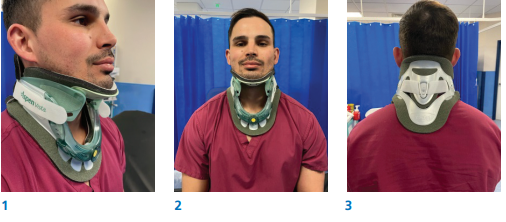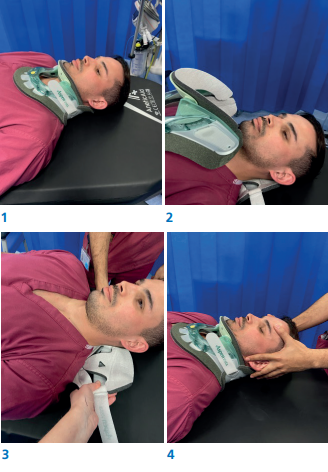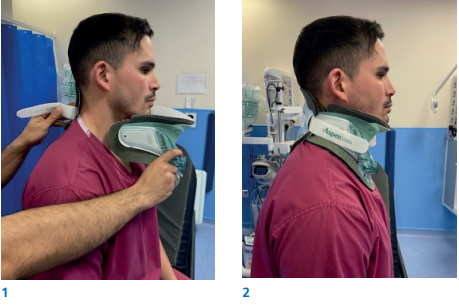Download and print as a PDF (3MB pdf)
On this page
Introduction
This information provides an overview of what to expect if you have sustained a cervical (neck) injury and have been advised by your Consultant to wear a spinal (hard) collar whilst it heals.
Below you will find details of your Collar Prescription. This provides specific guidance for you, such as the recommended duration of collar use (this could be up to 3 months), and how it should be applied.
If, after reading this leaflet, you have any further questions regarding your spinal collar, please speak to a member of the team who has been caring for you.
What is a spinal collar?
A spinal (cervical) collar is an orthosis designed to maintain your neck in correct alignment and limit the range of movement, this allows the bones in your neck to heal after injury. They are commonly used to manage spinal fractures in the neck which are being managed conservatively (without surgery), but can also be used to provide additional support to optimise healing post operatively. The type of collar you will be issued is dependent upon the clinical setting you are assessed in, and what the clinician deems will fit you most appropriately.
Spinal collar prescription
This is a form for you to fill in. Please print off the PDF version to obtain the form.
Make and size of collar:
Diagnosis:
Date of Injury:
How long is the collar needed?
When does the collar have to be worn? (please circle)
24hrs / When out of bed / When walking
What position can the collar be changed in? (please circle)
Lying / Sitting
Is a head hold needed? (please circle)
Yes / No
Can I shower/shave without the collar? (please circle)
Yes in standing / Yes in sitting / No
Follow up plan
Collar application

The spinal collar should be flush to the patients chin, ensuring only foam pads are touching the skin and the Velcro straps are roughly equal in length on opposing sides.
Collar change: lying
To provide the most efficient care, we recommend having everything you will need for the collar change readily available before starting to remove the panels. i.e. Spare pads, flannels / wipes, moisturiser / barrier cream.

Pictures 2 and 3: Removal of Spinal Collar (front and back panel) in lying, requiring two people.
Picture 4: The addition of a third person to provide a Head Hold, if this is indicated; this will be a Consultant led decision, see collar prescription. Head hold demonstrated as per SIA MASCIP guideline.
Collar change: sitting

Picture 2: Removal of front and back panel of Spinal Collar.
Collar care
We recommend your collar is removed and refitted once per day. This allows for the pads to be changed for clean ones and the skin to be checked for any areas of redness or broken skin. Please see your collar prescription on page 2 for advice on whether your collar can be changed in lying or sitting and the guidance on page 3 or 4 on how to do so. Please note your collar should never be changed in sitting if your collar prescription specifies it should be changed in lying.
Changing the pads
Your spinal collar should come with a set of spare collar pads, if you do not have these when you are ready to go home please speak to a member of staff. We recommend the collar pads are changed daily, when you have your collar care done. We suggest, when changing the pads, that you remove one pad at a time and replace with the clean one rather than removing all the pads at once as this helps ensure you are putting the replacement pads in the correct place. It is important to ensure that any hard plastic edges are not in contact with the skin.

The soiled pads should be washed with mild soap in warm water and allowed to air dry on a flat surface, do not put the collar pads in the washing machine or tumble dryer. If you feel your collar pads are no longer useable please contact the Spinal Practitioners at uhsussex.spinalpractitioners
Looking after your skin
When changing your collar, the skin on your neck should be cleaned, dried thoroughly and checked for any areas of redness or broken skin. When checking the skin you should pay particular attention around any bony prominences, such as under your chin, where the collar meets your chest and at the back of your head / neck. If you develop any areas of broken skin please contact your local GP or district nurse.
This leaflet is intended for patients receiving care in Brighton & Hove or Haywards Heath
The information in this leaflet is for guidance purposes only and is in no way
intended to replace professional clinical advice by a qualified practitioner.